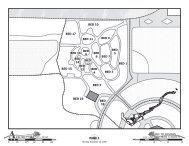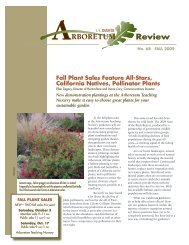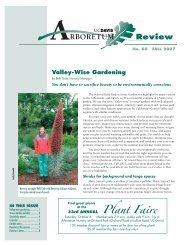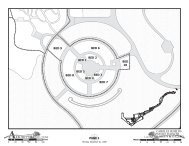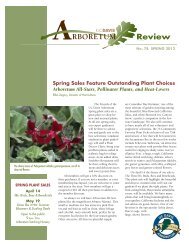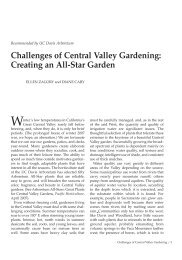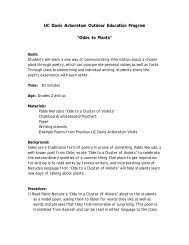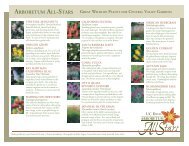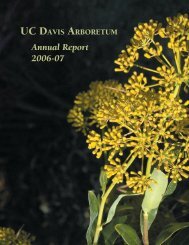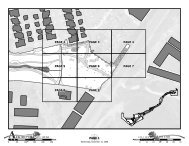Arboretum species list: Invertebrates, fishes, amphibians, reptiles ...
Arboretum species list: Invertebrates, fishes, amphibians, reptiles ...
Arboretum species list: Invertebrates, fishes, amphibians, reptiles ...
Create successful ePaper yourself
Turn your PDF publications into a flip-book with our unique Google optimized e-Paper software.
<strong>Arboretum</strong> Wildlife Management & Enhancement Plan Appendix G<br />
1<br />
ARBORETUM SPECIES LIST: INVERTEBRATES, FISHES,<br />
AMPHIBIANS, REPTILES, AND MAMMALS<br />
Species in boldface have been confirmed present in the <strong>Arboretum</strong>; other <strong>species</strong> expected<br />
based on range and habitat requirements.<br />
Scientific Name<br />
Common Name<br />
Abundance Conservation<br />
Status a<br />
Natural History<br />
CRAYFISH: Class Crustacea (from PB Moyle personal communication)<br />
Procambarus clarki<br />
red crayfish<br />
Extremely<br />
abundant<br />
Invasive<br />
Non-native. Native to South-Central U.S. and Northeastern<br />
Mexico. Burrows may damage banks and activity<br />
increases turbidity. Carnivorous. Common prey item of<br />
herons and Egrets. (Rogers 2000, Godfrey 2004).<br />
BUTTERFLIES: Order Lepidoptera (from Brock and Kaufman 2003, AM Shapiro personal communication)<br />
Battus philenor<br />
pipevine swallowtail<br />
Papilio zelicaon<br />
anise swallowtail<br />
Papilio rutulus<br />
western tiger<br />
swallowtail<br />
Pontia protodice<br />
checkered white<br />
Euchloe ausonides<br />
large marble<br />
Pieris rapae<br />
cabbage white<br />
Colias eurytheme<br />
orange sulphur<br />
Danaus plexippus<br />
monarch<br />
Limenitis lorquini<br />
Lorquin’s admiral<br />
Nymphalis antiopa<br />
mourning cloak<br />
Unconfirmed,<br />
but possibly<br />
present.<br />
Common<br />
Unconfirmed,<br />
but possibly<br />
present.<br />
Unconfirmed,<br />
but possibly<br />
present.<br />
Ubiquitous<br />
and<br />
abundant<br />
Common to<br />
abundant<br />
Unconfirmed,<br />
but possibly<br />
present.<br />
Unconfirmed,<br />
but possibly<br />
present.<br />
Unconfirmed,<br />
but possibly<br />
present in the<br />
<strong>Arboretum</strong><br />
Riparian<br />
Indicator<br />
Species<br />
Sensitive<br />
Sensitive<br />
Native. Frequents a variety of open habitats, open<br />
woodlands, and edges. Declining regionally. Flies Feb-<br />
Nov. 100% dependent on Aristolochia californica.<br />
Native. Late February-October. Habitat: bare hills, mountains,<br />
gardens, fields, vacant lots, and roadsides. Host plants: carrot<br />
family (Apiaceae), including sweet fennel, Foeniculum vulgare<br />
("anise") and poison hemlock<br />
Native. Habitat: riparian community; woodlands near<br />
rivers and streams, wooded suburbs, canyons, parks,<br />
roadsides, and oases. Flight period early spring to<br />
midsummer, in some places to late fall. Food plants:<br />
leaves of Populus fremontii, Salix, Platanus, Prunus (wild<br />
cherry), and Fraxinus. Nectar plants: Nectar from many<br />
flowers including thistles, abelia, California buckeye,<br />
zinnia, and yerba santa.<br />
Native. Current decreasing trend. Habitat: open grassland;<br />
occurrence irregular, sometimes very abundant. Always<br />
subject to extreme population fluxes, but a current declining<br />
trend is noteworthy in both the eastern and western United<br />
States. Food plants: many members of Brassicaceae.<br />
Native. Formerly common in the Central Valley, almost extinct<br />
regionally. Habitat: meadows, fields, farmlands, vacant lots,<br />
and along streamsides. Flight period Mar-Jun. Food plants:<br />
Brassicaceae: Brassica, Raphanus.<br />
Non-native. January-December. Host plants: various<br />
members of the mustard family, Brassicaceae.<br />
Native. Host plants: legume family, Fabaceae (various<br />
<strong>species</strong> of vetch, Vicia, spp.)<br />
Native. March-December. Habitat includes fields, meadows,<br />
weedy areas, marshes, and roadsides. Host plants: narrowleaf<br />
and broad-leaf milkweeds<br />
Native. Habitat: along valley streams from late spring to fall;<br />
has declined catastrophically. Has been reported at North<br />
Davis Pond. Food plants: Salix.<br />
Native. Regional collapse began 3 years ago, quite common<br />
previously. Over winters in Central Valley, adults emerge in<br />
Jan, 1st generation generally produced in mid May; migrate to<br />
Sierra Nevada to produce 2nd generation which migrates<br />
back to Valley in fall (primary flight season). Seen on willow<br />
catkins in early spring. Food plants: Salix, Ulmus, Celtis.
<strong>Arboretum</strong> Wildlife Management & Enhancement Plan Appendix G<br />
2<br />
Scientific Name<br />
Common Name<br />
Junonia coenia<br />
buckeye<br />
Vanessa cardui<br />
painted lady<br />
Vanessa annabella<br />
west coast lady<br />
Vanessa atalanta<br />
red admiral<br />
Vanessa virginiensis<br />
American lady<br />
Polygonia satyrus<br />
neomarsyas<br />
satyr comma or satyr<br />
anglewing<br />
Nymphalis californica<br />
California tortoise-shell<br />
Nymphalis milberti<br />
Milbert's tortoise-shell<br />
Phyciodes mylitta<br />
mylitta crescent<br />
Phyciodes campestris<br />
field crescent<br />
Satyrium sylvinum<br />
sylvinum<br />
sylvan hairstreak<br />
Lycaena xanthoides<br />
great copper<br />
Glaucopsyche lygdamus<br />
silvery blue<br />
Abundance Conservation<br />
Status a<br />
Common to<br />
abundant<br />
Often very<br />
abundant<br />
Unconfirmed,<br />
but possibly<br />
present.<br />
Unconfirmed,<br />
but possibly<br />
present.<br />
Unconfirmed,<br />
but possibly<br />
present.<br />
Unconfirmed,<br />
but possibly<br />
present.<br />
Unconfirmed,<br />
but possibly<br />
present.<br />
Unconfirmed,<br />
but possibly<br />
present.<br />
Unconfirmed,<br />
but possibly<br />
present.<br />
Unconfirmed,<br />
but possibly<br />
present.<br />
Unconfirmed,<br />
but possibly<br />
present.<br />
Unconfirmed,<br />
but possibly<br />
present.<br />
Unconfirmed,<br />
but possibly<br />
present.<br />
Riparian<br />
Indicator<br />
Species<br />
Riparian<br />
Indicator<br />
Species<br />
Riparian<br />
Indicator<br />
Species<br />
Riparian<br />
Indicator<br />
Species.<br />
Natural History<br />
Native. January-December. Habitat: open, sunny areas<br />
with low vegetation and some bare ground. Hosts: a<br />
variety of plants in the families Scrophulariaceae and<br />
Plantaginaceae, including English and broad-leafed<br />
plantains and the ground cover, common fog fruit,<br />
(Verbenaceae), Phyla<br />
Native. February-November, but often scarce or absent in<br />
July and August. Host plants: many weeds, especially<br />
members of the mallow family, Malvaceae, and various<br />
thistles, Cirsium sp. This is a migratory <strong>species</strong>. It enters<br />
our area late each winter from its overwintering grounds<br />
in the deserts of San Diego and Imperial Counties and<br />
Northern Mexico.<br />
Native. All year. Hosts: various weedy mallows, Malvaceae<br />
and, more rarely, stinging nettle, Urtica holosericea<br />
Native. All year. Habitat: moist woods, yards, parks, marshes,<br />
seeps, and moist fields. During migrations, the Red Admiral is<br />
found in almost any habitat from tundra to subtropics. Host:<br />
stinging nettle, Urtica holosericea<br />
Native. All year, most common in Spring and Fall. Hosts:<br />
everlastings (Asteraceae), Gnaphalium spp. and Antennaria<br />
spp.<br />
Native. Habitat: riparian vegetation and understory. Stable<br />
from Winters west, sporadic east of Winters. Adults long lived,<br />
often fly on warm late-winter days. Flight period Feb-Nov; two<br />
to three broods. Food plant: Urtica sp. (“stinging nettle”).<br />
Native. Except for the occasional midwinter hibernator, it is<br />
seen here only when migrating. March-June and again in late<br />
September-October. Habitat: chaparral, woodland, brush<br />
areas, forest clearings, edges. Host: California lilac,<br />
Ceanothus spp.<br />
Native. Occasionally seen in winter, otherwise March-June<br />
and, rarely, in autumn. Habitat: wet areas near woodlands,<br />
moist pastures, and marshes. Host: stinging nettle, Urtica<br />
holosericea<br />
Native. March-November. Host plants: native thistles, Cirsium<br />
spp., milk thistle Silybum marianum, and European thistles,<br />
Carduus spp.<br />
Native. March-October. Habitat: flats and open areas, fields,<br />
meadows, and streamsides from plains to mountains. Host:<br />
Aster spp.<br />
Native. Habitat: streamsides, willow thickets; in Valley and<br />
mountains. Local population at Old Davis Rd bridge extirpated<br />
by DWR vegetation clearing. Flight May-June. Food plants:<br />
various <strong>species</strong> of Salix, locally dependent on Salix exigua<br />
Native. Resident along South Fork Preserve and in UCD<br />
Riparian Reserve. Intensely local. Habitat: grassland and<br />
open riparian woodland. Populations holding regionally. Flight<br />
period May-early July. Food plants: Rumex spp., including R.<br />
pulcher, R. crispus, R. hymenosepalus. Nectar plants:<br />
Grindelia, Apocynum, Heliotropium.<br />
Native. Formerly widely distributed, went locally extinct in<br />
early 1970's, was reintroduced a decade later. In danger of<br />
extinction from fire, disking, herbicides, etc.Univoltine: flight<br />
period Mar-early May. Food plants: Lupinus spp., Lathyrus<br />
spp., Vicia spp. and other Fabaceae at Putah Creek, and Vicia<br />
on the valley floor.
<strong>Arboretum</strong> Wildlife Management & Enhancement Plan Appendix G<br />
3<br />
Scientific Name<br />
Common Name<br />
Atlides halesus<br />
great purple hairstreak<br />
Strymon melinus<br />
common or gray<br />
hairstreak<br />
Satyrium californica<br />
California hairstreak<br />
Satyrium auretorum<br />
gold-hunter's hairstreak<br />
Lycaena xanthoides<br />
great copper<br />
Lycaena helloides<br />
purplish copper<br />
Everes comyntas<br />
eastern tailed blue<br />
Plebeius acmon<br />
acmon blue<br />
Brephidium exilis<br />
western pygmy blue<br />
Leptotes marina<br />
marine blue<br />
Celastrina argiolus echo<br />
echo blue<br />
Pholisora catullus<br />
sooty wing<br />
Erynnis tristis<br />
sad dusky-wing<br />
Pyrgus communis<br />
common checkered<br />
skipper<br />
Pyrgus scriptura<br />
little checkered skipper<br />
Abundance Conservation<br />
Status a<br />
Unconfirmed,<br />
but possibly<br />
present.<br />
Common<br />
Unconfirmed,<br />
but possibly<br />
present.<br />
Unconfirmed,<br />
but possibly<br />
present.<br />
Unconfirmed,<br />
but possibly<br />
present.<br />
Unconfirmed,<br />
but possibly<br />
present.<br />
Unconfirmed,<br />
but possibly<br />
present.<br />
Common to<br />
abundant<br />
Unconfirmed,<br />
but possibly<br />
present.<br />
Unconfirmed,<br />
but possibly<br />
present.<br />
Unconfirmed,<br />
but possibly<br />
present.<br />
Unconfirmed,<br />
but possibly<br />
present.<br />
Unconfirmed,<br />
but possibly<br />
present.<br />
Unconfirmed,<br />
but possibly<br />
present.<br />
Natural History<br />
Native. Flight period Mar-Oct. Habitat: canopy <strong>species</strong><br />
(difficult to monitor). Feeds on common mistletoe<br />
(Phoradendron flavescens) in oaks and cottonwood. Flies in<br />
oak woodland and along stream bottoms where cottonwoods,<br />
sycamores, and ash trees grow; at times pupae may be<br />
gathered in numbers from litter beneath such trees on which<br />
mistletoe grows.<br />
Native. February-November. Hosts: various weeds<br />
including mallow, (Malvaceae), Vetch, Vicia spp., and<br />
turkey mullein, Eremocarpus setigerus.<br />
Native. Habitat: foothill chaparral or lower mountain habitats.<br />
Often seen in large numbers at buckwheat, dogbane, and<br />
other flowers, and adults also perch on larval foodplants. Flies<br />
in late spring or summer. Host: valley oak, Quercus spp.<br />
Native. May-July. Hosts: Oaks, Quercus spp.<br />
Native. Habitat: chaparral and scrub habitats. May-July.<br />
Hosts: dock Rumex spp.<br />
Native: Habitat: open, moist (often disturbed) habitats. Once<br />
common in fields, yards, vacant lots, and marshy areas. Food<br />
plants: many members of the Buckwheat family<br />
(Polygonaceae), including dock, sorrel (Rumex spp.), and<br />
knotweeds (Polygonum spp.). In dry yards and vacant lots:<br />
Wire Grass, Yard Knotweed (P. aviculare). In marshy areas:<br />
Common Knotweed (P. lapathifolium) and many others.<br />
Native. February-November. Hosts: herbaceous legumes,<br />
especially Spanish lotus, Lotus purshianus<br />
Native. Flight period Feb-Oct. Host plants: many<br />
Fabaceae: Lotus spp. Including L. scoparius, L.<br />
purshianus. Also Polygonum aviculare and Eriogonum<br />
spp.<br />
Native. April-December, Rare early in Season; often very<br />
abundant in fall. Smallest butterfly in North America. Hosts:<br />
members of the goosefoot family, Chenopodiaceae, including<br />
Russian thistle (tumbleweed), Salsola tragus<br />
Native. March-December, Irregular. Host (locally): wild<br />
licorice, Glycyrrhiza lepidota<br />
Native. February-June, two broods. Hosts: various shrubs and<br />
trees, including California lilac, Ceanothus spp., and California<br />
buckeye, Aesculus californica<br />
Native. March-November. Host plants: pigweed family,<br />
Amarathaceae.<br />
Native. March-October. Hosts: Quercus spp.<br />
Native. Habitat: backyards, vacant lots, city parks, fields,<br />
cultivated lands, and along roadsides. US & Canada south<br />
to Argentina. Food plants: many members of the<br />
Malvaceae, including Malvella leprosa and the weedy<br />
Malva.<br />
Native. Habitat:alkali flats, alkaline fields, usually at low<br />
elevations. In Northern California, most common in the<br />
Sacramento Delta and interior valleys. Flight period Mar-Oct.<br />
Sole food plant: Malvella leprosa.
<strong>Arboretum</strong> Wildlife Management & Enhancement Plan Appendix G<br />
4<br />
Scientific Name<br />
Common Name<br />
Paratrytone (Poanes)<br />
melane<br />
umber skipper<br />
Polites sabuleti<br />
sandhill skipper<br />
Ochlodes sylvanoides<br />
woodland skipper<br />
Hylephila phyleus<br />
fiery skipper<br />
Atalopedes campestris<br />
field skipper<br />
Lerodea eufala<br />
eufala skipper<br />
Hemileuca eglanterina/<br />
Pseudohazis eglanterina<br />
sheep moth<br />
Abundance Conservation<br />
Status a<br />
Unconfirmed,<br />
but possibly<br />
present.<br />
Common<br />
Unconfirmed,<br />
but possibly<br />
present.<br />
Common<br />
Unconfirmed,<br />
but possibly<br />
present.<br />
Unconfirmed,<br />
but possibly<br />
present.<br />
Riparian<br />
Indicator<br />
Species.<br />
Riparian<br />
Indicator<br />
Species<br />
FISHES: Class Osteichthyes (from Moyle 2002)<br />
Lavinia exilicauda<br />
hitch<br />
Orthodon<br />
microlepidotus<br />
Sacramento blackfish<br />
Pimephales promelas<br />
fathead minnow<br />
Cyprinnus carpio<br />
common carp<br />
Not present in<br />
waterway<br />
Stable<br />
population<br />
Most<br />
numerous<br />
fish in the<br />
Waterway<br />
Accounts for<br />
the majority<br />
of the fish<br />
biomass in<br />
the waterway<br />
watch <strong>list</strong><br />
Stable or<br />
increasing<br />
Aggressive<br />
invader<br />
Widespread<br />
and stable<br />
Natural History<br />
Native. Habitat: Riparian woodland in Valley, streamsides,<br />
clearings, trails, roadsides, at low elevations. Currently extinct<br />
below Lake Solano. Numbers declining in Sacramento and<br />
possibly Vacaville foothills. Flight period Mar-Jun and Jul-Oct.<br />
Food plants: various grasses.<br />
Native. March-November. Hosts: grasses, especially<br />
Bermuda Grass, Cynodon dactylon<br />
Native. Habitat requirements poorly understood, but<br />
associated w/ Quercus lobata. Flight period Jul-Oct. Food<br />
plants: various grasses, especially Elymus spp. The only<br />
butterfly <strong>species</strong> that nectars on the unusually shaped flower<br />
of Trichostemma lanceolatum.<br />
Native. Habitat: abundant on mowed lawns. Rare in<br />
Spring, increasingly abundant from June through autumn<br />
(a few to December). Hosts: grasses, Poaceae, especially<br />
Bermuda grass, Cynodon dactylon.<br />
Native. March-November, three broods. Hosts: grasses,<br />
Poaceae, especially Bermuda grass, Cynodon dactylon<br />
Native. Rare in Spring, common late July-early November<br />
Hosts: grasses, Poaceae, especially Johnson grass, Sorghum<br />
halepense and dallis grass, Paspalum spp.<br />
Native. Diurnal. Valley floor willow feeder. Extinct on campus.<br />
Formerly abundant near Old Davis Road bridge. Extant in<br />
Suisun and Delta and Bobelaine Sanctuary. Seen<br />
occasionally near Lake Solano. Overwinter as eggs on willow,<br />
adult emergence Sept-Oct.<br />
Native. Widespread in warm, low-elevation, slow-moving lakes<br />
and rivers and clear streams. May be found in low numbers in<br />
urban areas with turbid water. Very high temperature<br />
tolerance. Could be encouraged with improvements in water<br />
quality and submerged vegetation.<br />
Native. Abundant in warm, usually turbid waters of the<br />
Central Valley floor, often in highly modified habitats. Well<br />
adapted for survival in extreme environments.<br />
Hemoglobin has a high affinity for oxygen enabling this<br />
fish to survive in hypoxic environments.<br />
Non-native. Habitat: pools in small, muddy streams and<br />
ponds. Tolerant of extreme alkalinity, low dissolved<br />
oxygen, high levels of organic pollution and turbidity and<br />
high temperatures. High reproductive rates. Opportunistic<br />
bottom browsers on algae, diatoms, invertebrates and<br />
organic matter.<br />
Non-native. Most abundant in warm, turbid, eutrophic<br />
water at low elevations. They can survive in high<br />
turbidity, sudden temperature changes, high<br />
temperatures, and low oxygen concentrations. They can<br />
survive in deoxygenated water by gulping air at the<br />
surface. Omnivorous bottom feeders. They often uproot<br />
plants and disturb silty bottoms while feeding, removing<br />
food and cover from other <strong>fishes</strong> and increasing turbidity.<br />
Koi, the popular ornamental pond fish, are carp, and if<br />
they escape or are released, they can establish wild<br />
populations.
<strong>Arboretum</strong> Wildlife Management & Enhancement Plan Appendix G<br />
5<br />
Scientific Name<br />
Common Name<br />
Gambusia affinis<br />
western mosquitofish<br />
Archoplites interruptus<br />
Sacramento perch<br />
Lepomis cyanellus<br />
green sunfish<br />
Abundance Conservation<br />
Status a<br />
Abundant<br />
Not present in<br />
waterway<br />
Common<br />
AMPHIBIANS: Class Amphibia<br />
Batrachoseps attenuatus<br />
California slender<br />
salamander<br />
Pseudacris regilla<br />
Pacific treefrog<br />
Rana catesbeiana<br />
bullfrog<br />
Not present in<br />
the<br />
<strong>Arboretum</strong>,<br />
but have been<br />
found on<br />
Putah Creek<br />
not present<br />
Present, but<br />
no<br />
established<br />
breeding<br />
population<br />
Aggressive<br />
Invader<br />
SSSC<br />
Widespread<br />
and stable<br />
Natural History<br />
Non-native. Habitat: shallow, often stagnant, ponds and<br />
shallow edges of lakes and streams. Well adapted to high<br />
temperatures, extreme daily temperature fluctuations, and<br />
low dissolved oxygen concentration. Omnivorous,<br />
opportunistic top and bottom feeders. They can feed<br />
extensively on mosquito larvae and pupae, but they also<br />
feed on almost any small food or prey items available.<br />
Native. Adapted to withstand turbidity, high temperatures, high<br />
salinities and high alkalinities. Often excluded by nonnative<br />
sun<strong>fishes</strong> (Centrarchidae). Predatory, opportunistic, large<br />
individuals are piscivorous. Could be encouraged with<br />
Removal of non-native fish in the waterway. Establishment of<br />
aquatic plant beds.<br />
Non-native. Habitats include small warm streams, ponds<br />
and lake edges. Able to survive, high temperatures, low<br />
dissolved oxygen concentration, and very alkaline waters.<br />
Aggressive, territorial. Opportunistic predator and<br />
competitor with native fish.<br />
Native. Requires moist habitat. Found in several locations<br />
around Davis and Sacramento (DB Wake personal<br />
communication). Found above ground under leaf litter,<br />
downed logs etc. from first fall rain until the start of the dry<br />
season. Lives underground during dry times of the year.<br />
Apparently not excluded by human disturbance.<br />
(AmphibiaWeb 2005). Could be introduced to Redwood Grove<br />
if boards or logs were placed on the ground.<br />
Native. Seeks cover in many places, including rock fissures,<br />
under bark, in vegetation along streams, in rodent and other<br />
burrows, in nooks and crannies in buildings, and in culverts.<br />
Can be found in springs, ponds, irrigation canals, streams,<br />
and other bodies of water, but it has also been found as far as<br />
½ mile from water (Stebbins 1951). Out of the water, it<br />
frequents habitats like grassland, chaparral, woodland, desert<br />
oases, forest, and farmland (Stebbins 1985). Could be<br />
encouraged with addition of aquatic plants and small side<br />
pools for young<br />
Non-native. Voracious eater, threatens Pseudacris<br />
population. By eating larvae and tadpoles. (Stebbins<br />
2003)<br />
REPTILES: Class Reptilia (turtle <strong>species</strong> composition and abundance from Spinks et. al 2003)<br />
Chrysemys picta<br />
painted turtle<br />
Emys marmorata<br />
western pond turtle<br />
2 individuals<br />
found and<br />
removed in<br />
1998 and<br />
2000<br />
respectively<br />
Population<br />
dominated<br />
by adults<br />
and<br />
declining in<br />
SSSC<br />
the<br />
<strong>Arboretum</strong>.<br />
Population of<br />
approx. 75<br />
individuals.<br />
Non-native. Found in quiet, sluggish bodies of water with<br />
soft bottoms (Stebbins 2003). These turtles are<br />
omnivorous and will sometimes scavenge (Kipper 2002).<br />
The only native California turtle. Aquatic, requires aquatic<br />
vegetation to for juveniles to grow. Requires basking<br />
areas. Studied extensively in the <strong>Arboretum</strong> waterway<br />
from 1994-2001. Enhancement opportunities: create<br />
basking and nesting habitat. Head start juvenile turtles to<br />
augment population. Control non-native turtles. (Spinks et<br />
al 2003)
<strong>Arboretum</strong> Wildlife Management & Enhancement Plan Appendix G<br />
6<br />
Scientific Name<br />
Common Name<br />
Graptemys<br />
pseudogeographica<br />
false map turtle<br />
Pseudemys concinna<br />
river cooter<br />
Trachemys scripta<br />
elegans<br />
pond slider, red-eared<br />
slider<br />
Glyptemys<br />
muhlenbergii<br />
bog turtle<br />
Apalone spinifera<br />
(pallida)<br />
spiny softshell turtle<br />
Chelydra reganos e<br />
snapping turtle<br />
Kinosternon subrubrum<br />
eastern mud turtle<br />
Chinemys reevesii<br />
Reeves’ turtle<br />
Sceloporus occidentalis<br />
western fence lizard<br />
Eumeces gilberti<br />
Gilbert’s skink<br />
Elgaria multicarinata<br />
southern alligator lizard<br />
Contina tenuis<br />
sharp-tailed snake<br />
Coluber constrictor<br />
mormon<br />
western yellow-bellied<br />
racer<br />
Abundance Conservation<br />
Status a<br />
4 individuals<br />
found and<br />
removed in<br />
1994<br />
1 female<br />
individual<br />
found and<br />
removed in<br />
1998<br />
124<br />
individuals<br />
captured and<br />
removed<br />
from 1994 to<br />
2001<br />
1 individual<br />
died shortly<br />
after capture<br />
in 1998<br />
2 individuals<br />
caught and<br />
removed in<br />
1998 and<br />
2000,<br />
respectively<br />
1 individual<br />
found and<br />
removed in<br />
1994<br />
1 individual<br />
found and<br />
removed in<br />
1997<br />
1 individual<br />
found and<br />
removed in<br />
1998<br />
Common<br />
Common<br />
Common<br />
Common<br />
Common<br />
Invasive<br />
Federal<br />
Threatened,<br />
but not native<br />
to CA<br />
Natural History<br />
Non-native. Found in southern Canada and much of the<br />
Eastern U. S. Omnivorous, aquatic. Reproduction in<br />
<strong>Arboretum</strong> found to be limited (Spinks et al 2003).<br />
Non-native. Found in Eastern and Southeastern U. S.<br />
Primarily a river turtle, but found in other quieter habitats.<br />
Primarily herbivorous, but can be omnivorous (Gardiner<br />
2000).<br />
Non-native. Native to the Mississippi River Valley (Kuhrt<br />
and Dewey 2002). Sold frequently as pets, leading to<br />
widespread introduction. Thoroughly aquatic, often seen<br />
basking alone or in groups. Prefers quiet water with<br />
aquatic vegetation (Stebbins 2003). Reproductively<br />
successful in the <strong>Arboretum</strong> (Spinks et al 2003).<br />
Non-native. Native to swamps and bogs in the Eastern U.<br />
S. Prefers highly specific habitat that is disappearing due<br />
to natural and human-caused succession (Harding 2002).<br />
The story of this particular turtle is quite interesting<br />
(Spinks et al 2003).<br />
Non-native. Native in Central to Eastern U.S. Inhabits<br />
various freshwater systems with little aquatic vegetation<br />
and sandy or muddy bottoms with raised sandy areas for<br />
nesting. Able to breathe under water using pharyngeal<br />
linings, cloacal lining and skin. Preys on<br />
macroinvertebrates and fish (Bartholemew 2000).<br />
Non-native. Native to Southern Canada and North<br />
America East of the Rocky Mountains. It is currently<br />
illegal to import this turtle to California (Spinks et al 2003).<br />
Prefer muddy bottoms and aquatic vegetation for<br />
concealment. Omnivorous and predatory, will kill other<br />
turtles by decapitation (Bosch 2003).<br />
Non-native. This <strong>species</strong> is native to the Atlantic and Gulf<br />
Coast and the Mississippi River Valley. (Spinks et al 2003)<br />
Non-native. Found in Southern China, Korea, Taiwan and<br />
Japan. Popular in pet trade.<br />
Native. Occupies a great variety of habitats. Occasionally<br />
climbs trees, but often found on or near ground. Eats<br />
insects and spiders (Stebbins 2003).<br />
Native. Varied Habitats: grassland, salt flats, high desert, open<br />
chaparral, pinon-juniper woodland, open pine forest, rocky<br />
areas near springs and streams. (Stebbins 2003)<br />
Native. Found in grassland, chaparral, oak woodland, and<br />
open pine forest. Near streams with abundant plant cover, and<br />
may live in old woodpiles and trash heaps. Carnivorous, can<br />
eat black widows. (Stebbins 2003)<br />
Native. Found in woodland, grassland, broken chaparral,<br />
pastures or open meadows, on the edge of coniferous forests,<br />
among oaks, and forests usually near streams. Keeps out of<br />
sight hidden under logs, rocks and other objects. Often found<br />
on damp soil after rains. Feeds on slugs and their eggs<br />
(Stebbins 2003)<br />
Native. Favors open habitats, both semiarid and moist.<br />
Ground dwelling. Feeds on <strong>reptiles</strong>, small mammals, birds ad<br />
eggs. (Stebbins 2003)
<strong>Arboretum</strong> Wildlife Management & Enhancement Plan Appendix G<br />
7<br />
Scientific Name<br />
Common Name<br />
Pituophis catenifer<br />
catenifer<br />
pacific gopher snake<br />
Lampropeltis getula<br />
common kingsnake<br />
Thamnophis sirtalis fitchi<br />
valley garter snake<br />
Crotalus viridis reganos<br />
northern pacific<br />
rattlesnake<br />
MAMMALS: Class Mammalia<br />
Didelphis virginiana<br />
Virginia opossum<br />
Sorex ornatus<br />
ornate shrew<br />
Scapanus latimanus<br />
broad-footed mole<br />
Myotis yumanensis<br />
Yuma myotis<br />
Lasiurus borealis<br />
red bat<br />
Lasiurus cinereus<br />
hoary bat<br />
Episticus fuscus<br />
big brown bat<br />
Corynorhinus<br />
townsendii<br />
Townsend's big-eared<br />
bat<br />
Abundance Conservation<br />
Status a<br />
Common<br />
Common<br />
Common<br />
Rare locally<br />
Common<br />
Not confirmed<br />
in <strong>Arboretum</strong>,<br />
but likely<br />
present.<br />
Not confirmed<br />
in <strong>Arboretum</strong>,<br />
but likely<br />
present.<br />
Colony<br />
located<br />
under<br />
California<br />
Street Bridge<br />
Not<br />
confirmed in<br />
<strong>Arboretum</strong>,<br />
but likely<br />
present.<br />
Not confirmed<br />
in <strong>Arboretum</strong>,<br />
but likely<br />
present.<br />
Not confirmed<br />
in <strong>Arboretum</strong>,<br />
but likely<br />
present.<br />
In past,<br />
associated<br />
with the SSSC, 2<br />
Myotis<br />
colony under<br />
the California<br />
Street Bridge<br />
nd<br />
priority<br />
Natural History<br />
Native. Various habitats, especially common in grassland<br />
and open brushland. Good climber and burrower. Mimics<br />
rattlesnake when disturbed.Eats rodents, rabbits, moles,<br />
birds, eggs, nestlings, lizards and insects. (Stebbins<br />
2003)<br />
Native. Various Habitats. Eats snakes, lizards, small turtles,<br />
reptile eggs, frogs, birds, bird eggs, and small mammals.<br />
(Stebbins 2003) Found on Old Davis Rd. near Putah Creek.<br />
Native. Found in grassland, woodland, scrub, chaparral, forest<br />
and city lots. Tends to stay near water, excellent swimmer.<br />
“Spirited; often defends itself energetically when cornered.<br />
When caught it often bites and smears its captor with<br />
excrement and odorous contents of anal glands” (Stebbins<br />
2003). Eats fish, toads, frogs, tadpoles, salamanders and their<br />
larvae, birds and their eggs, small mammals, <strong>reptiles</strong>,<br />
earthworms, slugs and leeches (Stebbins 2003).<br />
Native. Found close to campus on Putah Creek. Various<br />
habitats. Produces neurotoxin, which can cause injury and<br />
death (Stebbins 2003). Not aggressive. Eat small mammals;<br />
ground nesting birds, <strong>amphibians</strong> and <strong>reptiles</strong> (ADW).<br />
Naturalized. Commonly photographed in West End Swale<br />
during trailmaster sessions. Habitat: cultivated and<br />
riparian areas at elevations lower than 1000m. (Wilson<br />
and Ruff 1999)<br />
Native. Restricted to the southern Pacific region. Found in<br />
Putah Creek Campus Reserve and Campus Ecosystem.<br />
Habitat: Mediteranean upland and marshland. (Wilson and<br />
Ruff 1999)<br />
Native. Found in Putah Creek Campus Reserve and Campus<br />
Ecosystem. Habitat: favors light soils, found throughout much<br />
of the state below 2000 ft.<br />
Native. Found in Western Canada, U.S., and Mexico.<br />
Insectivorous. Colony located under the California Street<br />
bridge. (Wilson and Ruff 1999)<br />
Native. Found in forested regions throughout Northern<br />
and Central America and parts of South America. Found<br />
at Briggs Hall on main campus. Insectivorous (Wilson and<br />
Ruff 1999).<br />
Native. Widespread throughout Canada, U.S. and Central<br />
America. Found in trees near clearings including city parks.<br />
Feeds on Moths, Beetles, flies and wasps. (Wilson and Ruff<br />
1999)<br />
Native. Found in North, Central, and South America as well as<br />
the West Indies. Habitat: cities, towns, and rural areas, not<br />
found in forested areas. Insectivorous. (Wilson and Ruff 1999)<br />
Native. Western U.S. through British Columbia.<br />
Uncommon in summer, often found in caves in winter<br />
months. Hibernate in caves during the winter months.<br />
Threats include disturbance, vandalism and loss of<br />
habitat. (Wilson and Ruff 1999)
<strong>Arboretum</strong> Wildlife Management & Enhancement Plan Appendix G<br />
8<br />
Scientific Name<br />
Common Name<br />
Antrozous pallidus<br />
pallid bat<br />
Abundance Conservation<br />
Status a<br />
not confirmed<br />
in <strong>Arboretum</strong>,<br />
but likely<br />
present.<br />
Tadarida brasiliensis<br />
Mexican free-tailed bat Common<br />
Canis latrans<br />
coyote<br />
Canis domesticus<br />
domestic dog<br />
Vulpes vulpes<br />
red fox<br />
Felis silvestris<br />
domestic cat<br />
Possibly one<br />
resident pair<br />
Common,<br />
brought by<br />
visitors<br />
formerly<br />
found on<br />
<strong>Arboretum</strong>,<br />
Common<br />
Erithrizon dorsatum Extremely<br />
North American porcupine rare here<br />
Procyon lotor<br />
Northern raccoon<br />
Mephitis mephitis<br />
striped skunk<br />
Sciurus carolinensis<br />
eastern gray squirrel<br />
Sciurus griseus<br />
western gray squirrel<br />
Sciurus niger<br />
fox squirrel<br />
Spermophilus beecheyi<br />
California ground<br />
squirrel<br />
not confirmed<br />
in <strong>Arboretum</strong>,<br />
but likely<br />
present.<br />
Confirmed<br />
near Putah<br />
Creek Lodge.<br />
Not found on<br />
<strong>Arboretum</strong>,<br />
but could<br />
establish<br />
population<br />
Rare in the<br />
<strong>Arboretum</strong><br />
Common<br />
Extremely<br />
abundant<br />
SSSC<br />
Threatened in<br />
WA; sensitive<br />
in OR<br />
Natural History<br />
Native. Found From Canada to Mexico. Habitat: rocky<br />
mountainous areas or open, sparsely vegetated grasslands.<br />
Roosts in buildings and rock cracks. Insectivorous, usually<br />
catiching prey on foliage or ground. Easily disturbed by<br />
humans. (Wilson and Ruff 1999)<br />
Native. Frequent campus buildings. Habitat: colonial in<br />
buildings, caves, mine shafts; migratory; found across<br />
southern US to Atlantic coast. Could be encouraged to<br />
roost in bat boxes. (Wilson and Ruff 1999)<br />
Native. Found throughout North and Central America.<br />
Incredibly adaptable. Omnivorous. Usually monogamous.<br />
Breeding occurs once a year in early to mid winter with a<br />
gestation period of 63 days. Litters average six altricial<br />
pups. Coyotes live an average of 8 years in the wild.<br />
There is great variation in social structure, from<br />
individuals living alone to large packs. (Wilson and Ruff<br />
1999)<br />
Domestic. No wild dogs live in the <strong>Arboretum</strong>, but<br />
domestic dogs are a common predator when brought by<br />
visitors and allowed to run off leash.<br />
Non-native. Prefer diverse habitats and edge habitats.<br />
Uncommon in Putah Creek Campus Reserve.<br />
Opportunistic hunters and scavengers. They prefer<br />
rodents, cottontails and jackrabbits, but they will also<br />
take birds, fruits and invertebrates. Principle vector and<br />
victim of rabies in the Northern Hemisphere. (Wilson and<br />
Ruff 1999)<br />
Domestic. House cats and ferral cats are common<br />
predaotrs in the <strong>Arboretum</strong>.<br />
Native. Northern North America. Found once on Putah Creek<br />
Campus reserve Poor eyesight, varied herbivorous diet. They<br />
can live at least ten years. Usually solitary except in winter<br />
months. (Wilson and Ruff 1999)<br />
Native. North and Central America. Found in Putah Creek<br />
Campus Reserve and Campus Ecosystem. Very well<br />
developed thermoregulatory ability allows them to inhabit hot<br />
climates. Found almost everywhere near water (Wilson and<br />
Ruff 1999). We did not observe this animal on the <strong>Arboretum</strong><br />
through any of our monitoring efforts, but it occurs on Putah<br />
Creek and within the city of Davis.<br />
Native. Found throughout North and Central America<br />
except in the hottest deserts and high mountains. Often<br />
near streams and other bodies of water. Does well in<br />
Agricultural areas, common in edge habitat. Omnivorous.<br />
(Wilson and Ruff 1999)<br />
Non-native. Native to Southern Canada and the United States<br />
east of the Mississippi. Omnivorous scavengers. Found in<br />
many habitats. (Wilson and Ruff 1999).<br />
Native. Distribution closely associated with oak-conifer<br />
woodlands. Distribution declining due to habitat loss.<br />
Herbivorous. (Wilson and Ruff 1999).<br />
Non-native. Native to the United States east of the<br />
Mississippi. Common in parks and cities (Wilson and Ruff<br />
1999). Recently invaded UC Davis Campus, including the<br />
<strong>Arboretum</strong>.<br />
Native. Most common in Agricultural lands. Significant<br />
pest to agriculture. Strictly ground dwelling opportunistic<br />
forager. (Wilson and Ruff 1999)
<strong>Arboretum</strong> Wildlife Management & Enhancement Plan Appendix G<br />
9<br />
Scientific Name<br />
Common Name<br />
Thomomys bottae<br />
Botta's pocket gopher<br />
Ondatra zibethicus<br />
muskrat<br />
Microtus californicus<br />
California vole<br />
Reithrodontomys<br />
megalotus<br />
western harvest mouse<br />
Peromyscus maniculatus<br />
deer mouse<br />
Mus musculus<br />
House mouse<br />
Rattus norvegicus<br />
Norway rat<br />
Rattus rattus<br />
Black rat, Roof rat<br />
Lepus californicus<br />
Black-tailed jackrabbit<br />
Sylvilagus audubonii<br />
Audubon's cottontail<br />
Abundance Conservation<br />
Status a<br />
Common in<br />
grassy areas<br />
Once<br />
common in<br />
the<br />
<strong>Arboretum</strong>,<br />
appears to<br />
have been<br />
extirpated.<br />
Not confirmed<br />
in <strong>Arboretum</strong>,<br />
but likely<br />
present.<br />
Not confirmed<br />
in <strong>Arboretum</strong>,<br />
but likely<br />
present.<br />
Not confirmed<br />
in <strong>Arboretum</strong>,<br />
but likely<br />
present.<br />
Unconfirmed,<br />
but likely<br />
present<br />
a Conservation Status<br />
Federal and State Designations<br />
Natural History<br />
Native. Virtually statewide, except higher elevations and<br />
extreme Northeast corner of the state. Found in open<br />
habitats. Both sexes burrow and individuals defend their<br />
own burrow systems. Considered a pest, but also<br />
important for soil aeration and production (Wilson and<br />
Ruff 1999).<br />
Native throughout North America. Semi-aquatic. Found on<br />
Putah Creek Campus Reserve.Crepuscular and nocturnal.<br />
They feed mainly on aquatic plants, but will also take animal<br />
material. (Wilson and Ruff 1999)<br />
Native. The only vole in the Central Valley. Found in Putah<br />
Creek Campus Reserve and Campus Ecosystem. Lowlands<br />
and foothills in much of California up to 1500m elevation in the<br />
Sierra Nevada. Herbivorous preferring grasses, sedges, and<br />
forbs. (Wison and Ruff 1999)<br />
Native. Habitat: varies, but often in brushy areas with dense<br />
grasses and open habitats; throughout California in low and<br />
medium elevations. Found in Putah Creek Campus Reserve<br />
and Campus Ecosystem. Opportunistic forager taking seeds,<br />
insects and herbs. (Wilson and Ruff 1999)<br />
Native. Habitat: nearly anywhere; one of the most common<br />
mammals in much of North America. Most widespread North<br />
American rodent. Found in Putah Creek Campus Reserve and<br />
Campus Ecosystem. Crepuscular and nocturnal. Opportunistic<br />
forager. Primary host of hauntavirus. (Wilson and Ruff 1999)<br />
Non-native. Found in Putah Creek Campus Reserve and<br />
Campus Ecosystem. Commensally with humans, also<br />
invading many habitats where it may be evicting many<br />
<strong>species</strong>. (Wilson and Ruff 1999)<br />
Common Invasive Non-native. Commensally with humans, also invading<br />
many habitats where it may be evicting many <strong>species</strong>.<br />
Common Invasive<br />
Common Invasive<br />
Common Invasive<br />
Non-native. Commensally with humans, also invading<br />
many habitats where it may be evicting many <strong>species</strong>.<br />
Native. Common in open fields adjacent to Garrod Rd.<br />
Found throughout most of California to about 2500m<br />
elevation.<br />
Native. Found throughout the <strong>Arboretum</strong>, but most<br />
abundant in large rosemary bushes of the Mediterranean<br />
Section. Very common in the southern 2/3 of California.<br />
Threatened or Endangered: Most birds are protected under the Migratory Bird Treaty Act (16 U.S.C. 703–711). However,<br />
before a plant or animal <strong>species</strong> can receive protection under the Endangered Species Act, it must first be placed on a<br />
federal or state <strong>list</strong> of endangered and threatened wildlife and plants. An “endangered” <strong>species</strong> is one that is in danger of<br />
extinction throughout all or a significant portion of its range. A “threatened” <strong>species</strong> is one that is likely to become<br />
endangered in the foreseeable future (USFWS 2006).<br />
California State Species of Special Concern: “Species of Special Concern (SSSC) status applies to animals not <strong>list</strong>ed<br />
under the federal Endangered Species Act or the California Endangered Species Act, but which nonetheless are declining<br />
at a rate that could result in <strong>list</strong>ing, or historically occurred in low numbers and known threats to their persistence currently<br />
exist.” (CDFG 2006)<br />
Watch<strong>list</strong>, stable or increasing, widespread and stable, and aggressive invader classifications to indicate distribution,<br />
status and lifestyle of each fish <strong>species</strong> after Moyle (2002).<br />
Sensitive: a <strong>species</strong> that is experiencing dramatic population declines across all or part of its range, but is not covered by<br />
federal or state protections.
<strong>Arboretum</strong> Wildlife Management & Enhancement Plan Appendix G<br />
10<br />
Riparian Indicator Species: a <strong>species</strong> that spends all or a significant portion of its life in riparian areas and is a good<br />
indicator of riparian habitat quality. Often tied to riparian resources, such as nectar sources or larval host plants in the<br />
case of Lepidopterans, for its survival.<br />
Invasive: a <strong>species</strong>, generally nonnative, that can outcompete native <strong>species</strong> by better exploiting resources or avoiding<br />
predation.<br />
Literature cited<br />
AmphibiaWeb: Information on amphibian biology and conservation. [web application]. 2006. Berkeley, California:<br />
AmphibiaWeb. Available: http://amphibiaweb.org/. (Accessed: 10 October 2005).<br />
Bartholomew, P. 2000. "Apalone spinifera" (On-line), Animal Diversity Web. Accessed January 06, 2006 at<br />
http://animaldiversity.ummz.umich.edu/site/accounts/information/Apalone_spinifera.html.<br />
Brock JP, Kaufman K. 2003. Butterflies of North America; Kaufman focus guides. New York: Houghton Mifflin Co. 384 p.<br />
Bosch, A. 2003. "Chelydra serpentina" (On-line), Animal Diversity Web. Accessed January 06, 2006 at<br />
http://animaldiversity.ummz.umich.edu/site/accounts/information/Chelydra_serpentina.html.<br />
CDFG. 2006. California Department of Fish and Game web page. http://www.dfg.ca.gov/hcpb/<strong>species</strong>/ssc/ssc.shtml.<br />
Accessed on 4 January 2006.<br />
Gardiner, K. 2000. "Pseudemys concinna" (On-line), Animal Diversity Web. Accessed January 06, 2006 at<br />
http://animaldiversity.ummz.umich.edu/site/accounts/information/Pseudemys_concinna.html.<br />
Godfrey LD. 2004. Rice Crayfish. In: UC IPM Pest Management Guidelines: Rice. UC ANR Publication 3465. University of<br />
California agriculture and natural resource. Davis (CA): IPM Education and Publications. Available from:<br />
http://www.ipm.ucdavis.edu.<br />
Harding, J. 2002. "Clemmys muhlenbergii" (On-line), Animal Diversity Web. Accessed January 06, 2006 at<br />
http://animaldiversity.ummz.umich.edu/site/accounts/information/Clemmys_muhlenbergii.html.<br />
Herpnet (On-line) Accessed at: http://herpnet.org/. Accessed on 10 October 2005.<br />
Knipper, K. 2002. "Chrysemys picta" (On-line), Animal Diversity Web. Accessed January 06, 2006 at<br />
http://animaldiversity.ummz.umich.edu/site/accounts/information/Chrysemys_picta.html.<br />
Kuhrt, T. and T. Dewey. 2002. "Trachemys scripta" (On-line), Animal Diversity Web. Accessed January 06, 2006 at<br />
http://animaldiversity.ummz.umich.edu/site/accounts/information/Trachemys_scripta.html.<br />
Moyle PB. 2002. Inland <strong>fishes</strong> of California: revised and expanded. Berkeley (CA): University of California Press. 502 p<br />
Rogers, J. 2000. "Procambarus clarkii" (On-line), Animal Diversity Web. Accessed January 06, 2006 at<br />
http://animaldiversity.ummz.umich.edu/site/accounts/information/Procambarus_clarkii.html.<br />
.<br />
Spinks PQ, Pauly GB, Crayon JJ, Shaffer HB. 2003. Survival of the Western Pond Turtle (Emmys marmorata) in an urban<br />
California Environment. Biological Conservation 113: 257-267.<br />
Stebbins, R.C. (1951). Amphibians of Western North America. University of California Press, Berkeley.<br />
Stebbins, Robert C. (1972). Amphibians and Reptiles of California. University of California Press, Berkeley, Los Angeles,<br />
London.<br />
Stebbins, Robert C. (1985). A Field Guide to Western Reptiles and Amphibians. Houghton Mifflin, Boston.<br />
Stebbins RC. 2003. A field guide to western <strong>reptiles</strong> and <strong>amphibians</strong>: Third edition [The Peterson field guide series].<br />
Boston (MA): Houghton Mifflin Co. 533 p.<br />
Wilson DE and Ruff S, editors. 1999. The Smithsonian book of North American mammals. Smithsonian Institution. 750 p.



